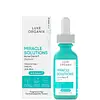What's inside
What's inside
 Key Ingredients
Key Ingredients

 Benefits
Benefits

 Concerns
Concerns

 Ingredients Side-by-side
Ingredients Side-by-side

Water
Skin ConditioningAlcohol Denat.
AntimicrobialButylene Glycol
HumectantIsopropyl Myristate
EmollientEthylhexyl Palmitate
EmollientNiacinamide
SmoothingGlyceryl Stearate
EmollientSilica
AbrasiveDimethicone
EmollientCetearyl Alcohol
EmollientPolyglyceryl-3 Methylglucose Distearate
EmulsifyingPEG-100 Stearate
Behenyl Alcohol
EmollientButyrospermum Parkii Butter
Skin ConditioningPhenoxyethanol
PreservativeCarbomer
Emulsion StabilisingTriethanolamine
BufferingAllantoin
Skin ConditioningCaprylhydroxamic Acid
Isopropyl Palmitate
EmollientCaprylyl Glycol
EmollientBoswellia Serrata Resin Extract
SmoothingDisodium EDTA
Salicylic Acid
MaskingMelaleuca Alternifolia Leaf Extract
PerfumingHippophae Rhamnoides Fruit Extract
Skin ConditioningGlycolic Acid
BufferingUlmus Davidiana Root Extract
Skin ConditioningPueraria Lobata Root Extract
HumectantPinus Palustris Leaf Extract
TonicOenothera Biennis Flower Extract
AstringentCapryloyl Salicylic Acid
ExfoliatingZinc PCA
HumectantMandelic Acid
AntimicrobialGluconic Acid
Lactic Acid
BufferingSodium Hydroxide
BufferingDenatonium Benzoate
MaskingLactobionic Acid
BufferingDioscorea Japonica Root Extract
Skin ConditioningViola Mandshurica Flower Extract
AntioxidantAloe Barbadensis Leaf Extract
EmollientLaminaria Japonica Extract
Skin ProtectingChrysanthemum Parthenium Extract
Skin ConditioningCalendula Officinalis Flower Extract
MaskingMentha Piperita Leaf Extract
Skin ConditioningThymus Vulgaris Extract
PerfumingAnthemis Nobilis Flower Extract
MaskingOriganum Vulgare Leaf Extract
Skin ConditioningUrtica Dioica Extract
AstringentSodium Hyaluronate Crosspolymer
HumectantSodium Hyaluronate
HumectantSalvia Officinalis Leaf Extract
CleansingLippia Citriodora Leaf Extract
AstringentBellis Perennis Flower Extract
Skin ConditioningGlycerin
HumectantEthylhexylglycerin
Skin ConditioningCitric Acid
BufferingWater, Alcohol Denat., Butylene Glycol, Isopropyl Myristate, Ethylhexyl Palmitate, Niacinamide, Glyceryl Stearate, Silica, Dimethicone, Cetearyl Alcohol, Polyglyceryl-3 Methylglucose Distearate, PEG-100 Stearate, Behenyl Alcohol, Butyrospermum Parkii Butter, Phenoxyethanol, Carbomer, Triethanolamine, Allantoin, Caprylhydroxamic Acid, Isopropyl Palmitate, Caprylyl Glycol, Boswellia Serrata Resin Extract, Disodium EDTA, Salicylic Acid, Melaleuca Alternifolia Leaf Extract, Hippophae Rhamnoides Fruit Extract, Glycolic Acid, Ulmus Davidiana Root Extract, Pueraria Lobata Root Extract, Pinus Palustris Leaf Extract, Oenothera Biennis Flower Extract, Capryloyl Salicylic Acid, Zinc PCA, Mandelic Acid, Gluconic Acid, Lactic Acid, Sodium Hydroxide, Denatonium Benzoate, Lactobionic Acid, Dioscorea Japonica Root Extract, Viola Mandshurica Flower Extract, Aloe Barbadensis Leaf Extract, Laminaria Japonica Extract, Chrysanthemum Parthenium Extract, Calendula Officinalis Flower Extract, Mentha Piperita Leaf Extract, Thymus Vulgaris Extract, Anthemis Nobilis Flower Extract, Origanum Vulgare Leaf Extract, Urtica Dioica Extract, Sodium Hyaluronate Crosspolymer, Sodium Hyaluronate, Salvia Officinalis Leaf Extract, Lippia Citriodora Leaf Extract, Bellis Perennis Flower Extract, Glycerin, Ethylhexylglycerin, Citric Acid
Water
Skin ConditioningEthylhexyl Methoxycinnamate
UV AbsorberMethylene Bis-Benzotriazolyl Tetramethylbutylphenol
UV FilterDecyl Glucoside
CleansingPropylene Glycol
HumectantXanthan Gum
EmulsifyingButyl Methoxydibenzoylmethane
UV AbsorberHydroxyethyl Acrylate/Sodium Acryloyldimethyl Taurate Copolymer
Emulsion StabilisingSaccharide Isomerate
HumectantC15-19 Alkane
SolventCyclopentasiloxane
EmollientDimethicone
EmollientIsohexadecane
EmollientPolysorbate 60
EmulsifyingOctyldodecanol
EmollientOctyldodecyl Xyloside
EmulsifyingPEG-30 Dipolyhydroxystearate
EmulsifyingPhenoxyethanol
PreservativeSolanum Lycopersicum Fruit Extract
AntioxidantParfum
MaskingEDTA
Citric Acid
BufferingSodium Hyaluronate
HumectantWater, Ethylhexyl Methoxycinnamate, Methylene Bis-Benzotriazolyl Tetramethylbutylphenol, Decyl Glucoside, Propylene Glycol, Xanthan Gum, Butyl Methoxydibenzoylmethane, Hydroxyethyl Acrylate/Sodium Acryloyldimethyl Taurate Copolymer, Saccharide Isomerate, C15-19 Alkane, Cyclopentasiloxane, Dimethicone, Isohexadecane, Polysorbate 60, Octyldodecanol, Octyldodecyl Xyloside, PEG-30 Dipolyhydroxystearate, Phenoxyethanol, Solanum Lycopersicum Fruit Extract, Parfum, EDTA, Citric Acid, Sodium Hyaluronate
 Reviews
Reviews

Ingredients Explained
These ingredients are found in both products.
Ingredients higher up in an ingredient list are typically present in a larger amount.
Citric Acid is an alpha hydroxy acid (AHA) naturally found in citrus fruits like oranges, lemons, and limes.
Like other AHAs, citric acid can exfoliate skin by breaking down the bonds that hold dead skin cells together. This helps reveal smoother and brighter skin underneath.
However, this exfoliating effect only happens at high concentrations (20%) which can be hard to find in cosmetic products.
Due to this, citric acid is usually included in small amounts as a pH adjuster. This helps keep products slightly more acidic and compatible with skin's natural pH.
In skincare formulas, citric acid can:
While it can provide some skin benefits, research shows lactic acid and glycolic acid are generally more effective and less irritating exfoliants.
Most citric acid used in skincare today is made by fermenting sugars (usually from molasses). This synthetic version is identical to the natural citrus form but easier to stabilize and use in formulations.
Read more about some other popular AHA's here:
Learn more about Citric AcidDimethicone is a type of synthetic silicone created from natural materials such as quartz.
What it does:
Dimethicone comes in different viscosities:
Depending on the viscosity, dimethicone has different properties.
Ingredients lists don't always show which type is used, so we recommend reaching out to the brand if you have questions about the viscosity.
This ingredient is unlikely to cause irritation because it does not get absorbed into skin. However, people with silicone allergies should be careful about using this ingredient.
Note: Dimethicone may contribute to pilling. This is because it is not oil or water soluble, so pilling may occur when layered with products. When mixed with heavy oils in a formula, the outcome is also quite greasy.
Learn more about DimethiconePhenoxyethanol is a preservative that has germicide, antimicrobial, and aromatic properties. Studies show that phenoxyethanol can prevent microbial growth. By itself, it has a scent that is similar to that of a rose.
It's often used in formulations along with Caprylyl Glycol to preserve the shelf life of products.
Sodium Hyaluronate is hyaluronic acid's salt form. It is commonly derived from the sodium salt of hyaluronic acid.
Like hyaluronic acid, it is great at holding water and acts as a humectant. This makes it a great skin hydrating ingredient.
Sodium Hyaluronate is naturally occurring in our bodies and is mostly found in eye fluid and joints.
These are some other common types of Hyaluronic Acid:
Learn more about Sodium HyaluronateWater. It's the most common cosmetic ingredient of all. You'll usually see it at the top of ingredient lists, meaning that it makes up the largest part of the product.
So why is it so popular? Water most often acts as a solvent - this means that it helps dissolve other ingredients into the formulation.
You'll also recognize water as that liquid we all need to stay alive. If you see this, drink a glass of water. Stay hydrated!
Learn more about Water